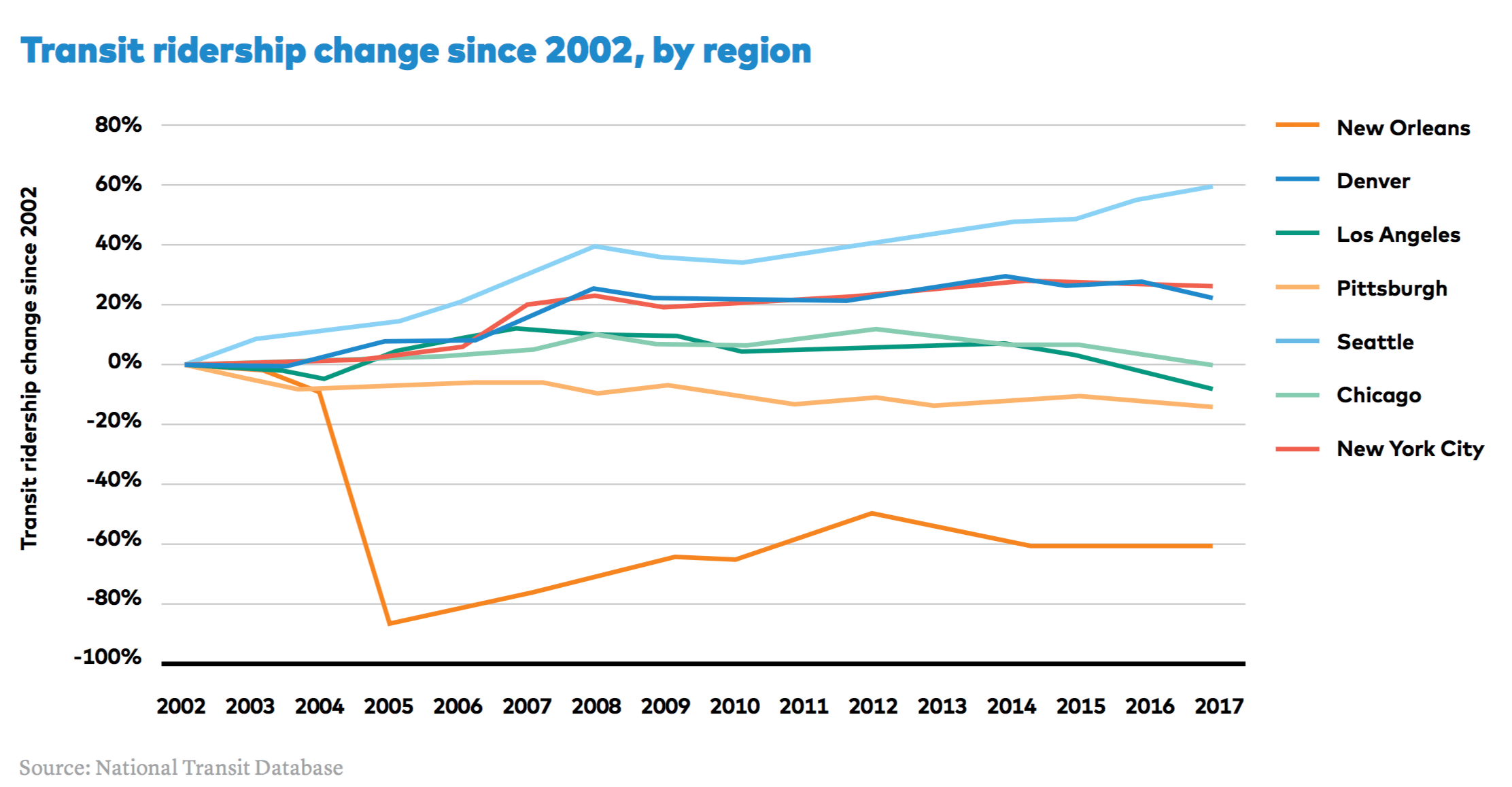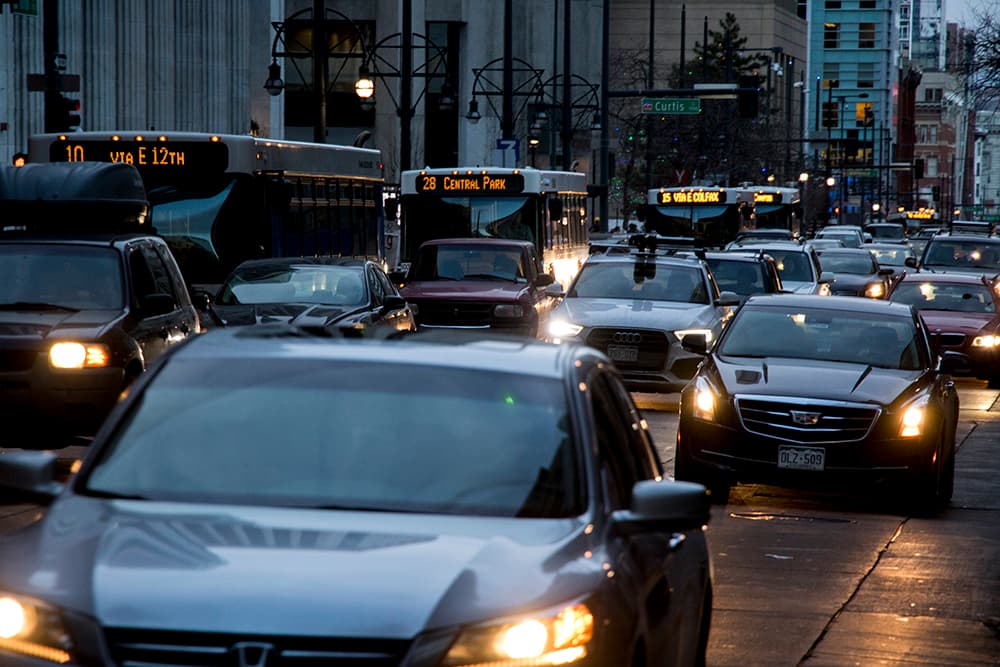With the Regional Transportation District's trains constantly under the media microscope, it's easy to forget that Denver's buses are the heart of the transit system. They serve more than double the riders and have the potential to carry far more. Yet bus ridership keeps falling while rail passengers multiply.
Denver has the bus blues for a bunch of reasons, according to a new report from Transit Center, a national foundation aimed at improving transit in cities. It's called "Who's on Board: How to Win Back America's Transit Riders."
The study surveyed 1,700 riders in seven regions. The takeaway for Denver: RTD and the city have neglected the bus system for the past 15 years while focusing on sprawling rail projects.
That's not a total knock on the light rail and commuter lines -- they're crucial to Denver's transit network -- but fewer people live and work on in the outskirts and exurbs than in the denser city neighborhoods served by buses, Transit Center Executive Director David Bragdon said.
It's a pattern he doesn't want to see continue.
"That really needs to fundamentally change," Bragdon said. "RTD has seen themselves as a construction company whose mission is to build transit as far away from the city as possible, including corners of the region where not a lot of people are riding."

Pauletta Tonilas, assistant general manager, communications, told Denverite the transit agency is planning to overhaul its entire bus system to serve more people more effectively. It will be a multiyear process.
Rail projects were funded with the 2004 voter-approved FasTracks tax hike, which cannot fund base bus service. Money from buses, however, is fair game for rail projects.
"We have been focused on the build-out of rail because that's what the people wanted," Tonilas said. "Constituents across the eight-county area voted for it."
Passengers took almost 66 million bus trips in 2017, according to the Federal Transit Administration. Rail lines handled 31.6 million trips.
The report compares Denver to six other regions, including Seattle, which has invested more in buses.
The Pacific Northwest city has added frequency, bus-only lanes and dignified bus shelters with real-time arrival information while simultaneously investing in rail. Seattle's overall transit ridership is climbing as a result, bucking the national trend.
Meanwhile RTD routinely cuts bus service as it wrestles with a driver shortage. Denver has just two streets, Broadway and Lincoln, with bus-only lanes, though the agency has enhanced reliability with signals that prioritize buses at intersections.
RTD is losing two kinds of transit riders, according to the report: People who abandoned transit altogether and people who simply use it less. That group accounts for 44 percent of the RTD riders surveyed. Just 23 percent of people surveyed increased their transit use or began riding for the first time recently.
Compared to other cities, RTD riders don't use transit much for trips other than commuting, the report found.
"I think from our perspective it's important that transit agencies listen to their all-purpose riders and regular transit riders who have been with the system for a while, and the riders who know how the system can be improved," said Mary Buchanan, who co-authored the report. "Transit agencies will have more luck with improving service and encouraging those people to ride more than having these pie-in-the sky ideas focused on some elusive new set of riders who have never ridden transit before."
The same enhancements that will win riders back will, by a matter of course, attract new riders, she said. The most important thing, according to Transit Center, is to paint bus lanes quickly and accelerate the Colfax bus rapid transit project.
One enhancement, which RTD will launch later this year, is discounted fares for kids and low-income riders. The report applauds Seattle for having similar fares.
"We redesigned our fare structure and that was bold," RTD's Tonilas said.
Ride-hailing companies and cheap parking nibble away at RTD.
The report found, as have local and national studies, that companies like Uber and Lyft compete with transit nationally and locally. While Denverites use the cars to connect to transit, those surveyed said they take transit less often (by at least one day) and hail rides more often.
Tonilas says RTD sees those companies as friends, not enemies. In fact RTD just allied with Uber. The company's app now displays the cost and real-time schedule of bus and train routes so that people can easily choose how to move around the city. Riders can also buy fares for public transportation on the private company's app.
Transit Center is more than skeptical. Researchers think it's just a way to send more people to Uber.
"We think that some transit agencies are rushing into agreements with providers without really thinking through all the implications," Bragdon said. "Sometimes they're making these agreements because they think the word 'partnership' sounds catchy and wonderful, but it doesn't necessarily work well for the public."
In some cases, free and cheap parking has steered riders away from transit, the report says.

RTD will embark on a plan to revamp bus service. Here's the thing: The city just did that.
RTD will put out a call for consultants this spring to build a plan that overhauls its entire bus network. Tonilas compared the redesign to what Houston recently did, recently adjustin its routes to be more efficient and serve more people -- ridership rose there.
It's been more than two years since the Hancock administration embarked on its first-ever transit plan, which centers on a fast, frequent, reliable bus and rail network in the city proper. The plan recommends buying service from the transit agency to fill critical service voids and repurposing car lanes for buses that carry more people.
The plan is unfunded. Mayor Michael Hancock has floated the idea of another regional tax increase to help fund the vision.
"Mayor Hancock has at least rhetorically recognized the importance of better transit, but they need to step it up," Bragdon said.
As for RTD, it has a legal mandate to serve the entire region, which is why the system covers more land area, but fewer people than it might if it were more centralized.
"What our plan will try to achieve is high frequency, reliability and faster speeds," Tonilas said. "These are the three core things to improve transit, so the fact that Denver has embarked upon this is great, but RTD is the transit agency for the eight-county area. We are looking at it much broader than the Denver study."













